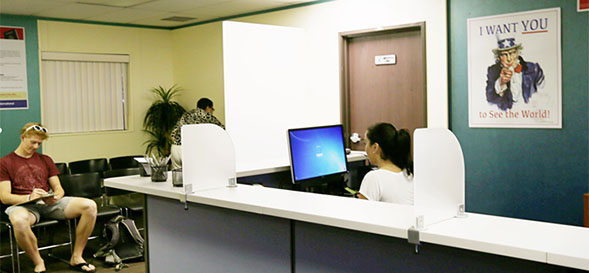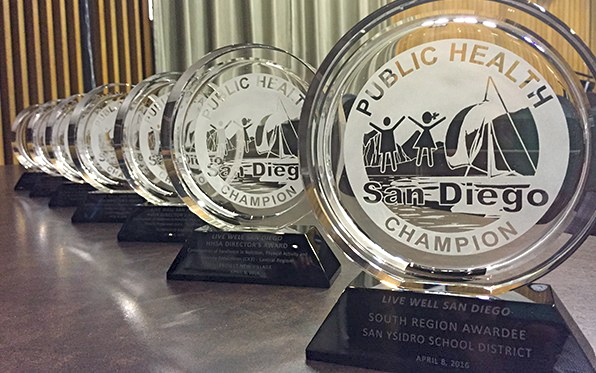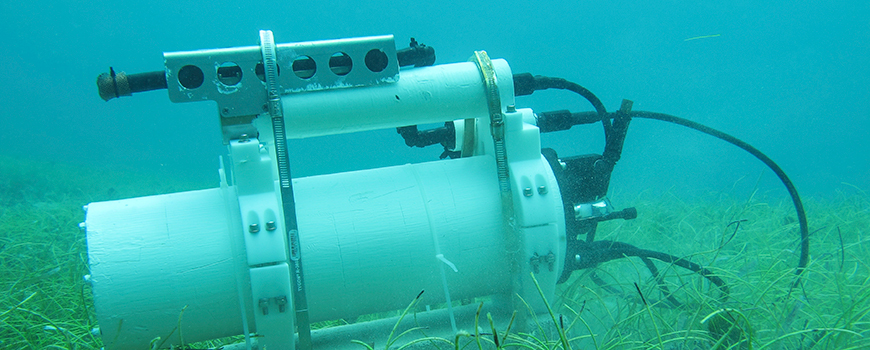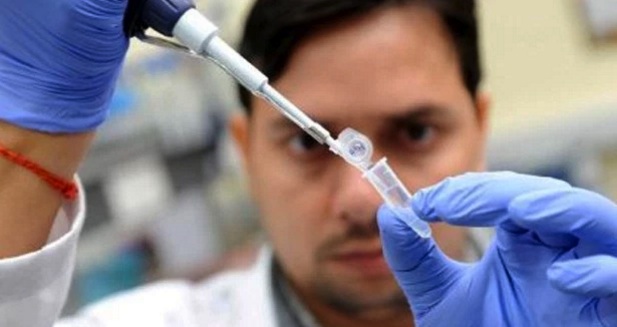Daily Business Report-April 11, 2016
The Mesa Consortium will carry out extensive immunological analyses from Human Vaccines Project’s clinical research studies.
San Diego Becomes Research Hub
For New Human Vaccines Project
Four scientific institutions — University of California, San Diego, J. Craig Venter Institute, La Jolla Institute for Allergy and Immunology and The Scripps Research Institute — have teamed up to create the “Mesa Consortium,” a new scientific hub for the Human Vaccines Project.

Under a collaborative agreement, the Mesa Consortium and the Human Vaccine Project aim to transform current understanding of the human immune system and expedite development of vaccines and biologics to prevent and treat many global diseases.
The Human Vaccines Project is a new global initiative that brings together leading research centers, pharmaceutical companies and state-of-the-art machine-learning methods to tackle the unprecedented mission of decoding the human immune system to accelerate the development of new vaccines and immunotherapies against major infectious diseases and cancers.
“Vaccines have helped us eradicate smallpox and nearly eradicate polio, but we have not yet experienced the same vaccine successes for global killers like HIV/AIDS, tuberculosis, malaria, cancer and other diseases,” said Wayne C. Koff, president and CEO of the Human Vaccines Project. “We need new approaches to address major gaps in knowledge, leverage recent technological advances and hasten vaccine development.
“To this end, the Mesa Consortium brings an unparalleled and complementary set of scientific capabilities in the areas of immunology, vaccines and immunotherapeutic research to the Project’s network. We look forward to major contributions toward deciphering the key principles of human immunity and ushering in a new era of global disease prevention and control.”
The Mesa Consortium will carry out extensive immunological analyses from the Project’s clinical research studies designed to answer specific questions about human immunity. The Mesa Consortium will also serve as the Project’s bioinformatics core.
“Driven by partnerships with leading academic centers, and enabled by new technologies and a scientific plan focused on solving the main barriers to developing new immune-based interventions, we believe our collaboration with the Project could help to transform global efforts in vaccine and immunotherapeutic development,” said UC San Diego Chancellor Pradeep K. Khosla.
“New genetic and immune monitoring technologies are enabling an unprecedented look at the human immune system, and are generating extensive amounts of data,” said J. Craig Venter, PhD, founder, chairman and CEO of the J. Craig Venter Institute. “When combined with sophisticated bioinformatics analyses, we may soon be able to unlock the principles of how to stimulate and direct immune responses against some of the world’s most pressing diseases. We are very pleased to be bringing the Mesa’s unparalleled scientific capacity to this global — and potentially transformative — initiative.”
About the Human Vaccines Project
The Human Vaccines Project is a nonprofit public-private partnership with the mission to accelerate the development of vaccines and immunotherapies against major infectious diseases and cancers by decoding the human immune system. The Project, incubated initially at the International AIDS Vaccine Initiative (IAVI), has a growing list of partners and financial supporters, including the Robert Wood Johnson Foundation, John D. and Catherine T. MacArthur Foundation, GSK, MedImmune, Sanofi Pasteur, Crucell/Janssen, Regeneron, Pfizer, Aeras, Vanderbilt University Medical Center, UC San Diego, The Scripps Research Institute, J. Craig Venter Institute and La Jolla Institute for Allergy and Immunology. The Project brings together leading academic research centers, industrial partners, nonprofits and governments to address the primary scientific barriers to developing new vaccines and immunotherapies, and has been endorsed by 35 of the world’s leading vaccine scientists.
___________________________________

India in Talks to Buy 40
San Diego-Built Predator Drones
Reuters
India is in talks with the United States to purchase 40 Predator XP surveillance drones made in San Diego to help monitor its borders with Pakistan and China, officials said.
India is trying to equip the military with more unmanned technologies to gather intelligence as well as boost its firepower along the vast land borders. It also wants a closer eye on the Indian Ocean.
New Delhi has already acquired surveillance drones from Israel to monitor the mountains of Kashmir, a region disputed by the nuclear-armed South Asian rivals and the cause of two of their three wars.
As defense ties deepen with the United States, which sees India as a counterweight to China in the region, New Delhi has asked Washington for the Predator series of unmanned planes built by San Diego-based General Atomics, military officials said.
“We are aware of Predator interest from the Indian Navy. However, it is a government-to-government discussion,” Vivek Lall, chief executive of U.S. and International Strategic Development at General Atomics, told Reuters.
The U.S. government late last year cleared General Atomics’ proposal to market the unarmed Predator XP in India. It was not clear when the delivery of the drones would take place.
The Indian navy wants them for surveillance in the Indian Ocean, where the pilotless aircraft can remain airborne for 35 hours at a stretch, at a time when the Chinese navy is expanding ship and submarine patrols in the region.
Moves by India to enhance its defense capabilities have in the past provoked sharp reactions from Islamabad, where the government and military are worried about falling further behind their bigger rival in the arms race.
India’s air force has also asked Washington about acquiring around 100 armed Predator C Avenger aircraft, which the United States has used to carry out strikes against Islamist militants in Pakistan’s northwest and neighboring Afghanistan.
But it would need clearance from the Missile Technology Control Regime group of 34 nations as well as approval from U.S. Congress before any transfer of lethal Predators could happen, officials said.
The push for the drones comes as U.S. Defense Secretary Ash Carter traveled to India for talks to cement military collaboration in the final months of the Obama administration.

SDSU Opens Passport Office
SDSU NewsCenter
A new Passport Acceptance Facility has opened at San Diego State University’s International Student Center on the west side of campus near 55th Street and Aztec Circle Drive.
The facility is a convenient one-stop application site providing streamlined services from photos to document processing for SDSU students, faculty and staff as well as College area residents and the greater San Diego community. It also is one of only four such facilities in San Diego County that doesn’t require an appointment and is open weekdays on a walk-in basis.
“We’re excited to have a passport office open for our campus community and the surrounding region,” said International Student Center Director Noah Hansen. “This is a wonderful opportunity to show that we’re here to help and support the community at large by offering this convenient and efficient service.”
According to Hansen, there are thousands of passport acceptance facilities in the United States, but most facilities are in post offices. Only a few California universities have such sites.
“As a campus that is known for its international programs and commitment for preparing its students to be global citizens, SDSU is a natural fit for such a facility,” Hansen said. “It is a much-needed campus service and hopefully it will encourage students and the entire campus community, including local residents, to travel and study abroad.”
The office provides information and services on how to obtain, replace or renew a U.S. passport. Passport application materials are forwarded to the State Department for processing and passports and/or passport cards are mailed to the applicant’s home in approximately four weeks.
The International Student Center is at 1261 Canyon Crest Drive. It is open to the campus community and the public Monday through Friday from 9 a.m. to 3 p.m. For more information about passport services at SDSU, visit the passport office website.

San Diego Ranked 2nd
Nationally in Solar Output
By City News Service
San Diego ranks second in the United States in electrical output from solar energy, and fourth on a per-capita basis, according to the annual “Shining Cities” report released Friday by Environment California. At the end of 2015, San Diego was producing 189 megawatts from its solar panels, 40 megawatts more than the year before, the report said. Only Los Angeles, with 215 megawatts, was higher.
San Diego was producing 136 watts per capita of solar power, fourth behind Honolulu, Indianapolis and San Jose, according to Environmental California. The per capita total at the end of 2014 was 110 watts.
“San Diego continues to lead the way in solar energy and remains a shining example to other cities when it comes to improving our environment through innovation,” Mayor Kevin Faulconer said. “Increasing solar energy will help reach our goal of 100 percent renewable energy use in the city by 2035 — a key element of San Diego’s landmark Climate Action Plan.”
The plan to address climate change was approved by the City Council in December, and includes a series of goals for generating clean power, energy efficiency, and the use of public transit.
Other cities high on the total solar output list were Phoenix, Honolulu, San Jose, Indianapolis, San Antonio, New York, Albuquerque and Las Vegas. While No. 1 for total output, Los Angeles ranked 15th on a per-capita basis.

County Honors Achievements
Sixteen individuals and organizations were honored by the County on Friday for their achievements in improving the health and well-being of San Diego residents and communities.
Read the names of the honorees…
National Funding Appoints First Female
President in Alternative Lending Industry

San Diego-based National Funding, one of the largest private lenders of small business loans, announced today that Torrie Inouye has been named the company’s president. Inouye will report directly to founder and CEO Dave Gilbert.
Inouye was promoted from executive vice president of data and analytics. The company said she is the first female president in the alternative lending industry.
“Torrie has played a critical role in our success to date, and her appointment as president is a natural extension of the work she has already taken on,” said Gilbert. “We trust Torrie to lead our company through its next growth phase.”
Gilbert said National Funding has experienced a 172 percent revenue growth surge over the past three years, which necessitated the need for a leader of overall business operations. The company’s management team saw Inouye as a natural fit for president. As executive vice president, she worked with the company’s executive team.
Inouye previously worked as staff business analyst for Intuit, where she led a team of analysts in the Turbo Tax division. She also served in a variety of analytics posts at Union Bank. Inouye began her career at National Funding upon her graduation from Stanford University, working there during the company’s early years and returned in 2014.
SPAWAR Awards $12.9M
Contract to General Dynamics
General Dynamics has received a two-year, $12.9 million contract modification from the Space and Naval Warfare Systems Command in San Diego to produce software-based radio systems for installation aboard U.S. Navy submarines and surface vessels.
The Defense Department said the company will continue to build AN/USC-61(C) digital modular radios and provide sparing components, supplies and support services to the military service.
The modification brings the total value of the contract awarded by the Space and Naval Warfare Systems Command to about $304.1 million.
AN/USC-61(C) DMRs are designed to operate across multiple waveforms and seek to help military users secure tactical voice and data communications.
General Dynamics’ mission systems unit will perform work at company facilities in Arizona, California and Pennsylvania through October 2018.

Scientists Recommend Quick Steps
To Combat West Coast Seawater Chemistry
Scripps News
Global carbon dioxide emissions are triggering permanent changes to ocean chemistry along the North American West Coast that require immediate, decisive action to combat.
That action includes development of a coordinated regional management strategy, concluded a panel of scientific experts including Andrew Dickson, a professor of marine chemistry at Scripps Institution of Oceanography at UC San Diego.
A failure to adequately respond to this fundamental change in seawater chemistry, known as ocean acidification, is anticipated to have devastating ecological consequences for the West Coast in the decades to come, the 20-member West Coast Ocean Acidification and Hypoxia Science Panel warned in a comprehensive report unveiled April 4.
“Increases in atmospheric carbon dioxide emissions from human activities are not just responsible for global climate change; these emissions also are being absorbed by the world’s oceans,” said Alexandria Boehm, co-chair of the Panel and a professor of Civil and Environmental Engineering at Stanford University. “Our work is a catalyst for management actions that can address the impacts of ocean acidification we’re seeing today and to get ahead of what’s predicted as ocean chemistry continues to change.”

Survey Shows Support for
Proposed Infrastructure Measure
By City News Service
A lot of work is ahead for the San Diego Association of Governments in the event it champions a proposed countywide half-cent sales tax increase that would fund regional infrastructure projects, agency Chairman Ron Roberts said Friday.
His remarks came after SANDAG’s Board of Directors was presented with results of a survey on a prospective ballot measure that might go before area voters in the November general election.
About 68 percent of about 1,200 respondents questioned between March 28 and April 3 were inclined to vote for the measure when read the proposed ballot summary — above the two-thirds that would be necessary for passage of a tax hike.
However, when the respondents were given arguments for and against the plan, support dropped to 62 percent, below the threshold.
“We’ve got a lot of work to do, but we’ve got a lot of support,” said Roberts, a county supervisor.
Backing for the proposed ballot measure was higher in the most recent survey, compared to polls taken in April last year and again last November.
The SANDAG directors — consisting of elected officials from the region’s 18 cities, county supervisors and leaders of other agencies — also heard from opponents of the measure.
Several representatives of environmental groups and organized labor said they would actively campaign against the plan because they believe proposed road and freeway enhancements would worsen climate change.
The plan currently calls for 14 percent of the revenue from the tax hike to go to freeway projects, while another 26 percent would pay for local road repair. The remainder would be spent on public transit, management of open space and complying with state water quality mandates.
County Supervisor Dianne Jacob said the proposed ballot language “raises expectations” with promises of “repairing streets and filling potholes in every community.”
It would be hard for SANDAG to “deliver on the promise,” especially when voters are fed up with conditions of area roadways, she said.
San Marcos Mayor Jim Desmond said voters could be misled by ballot language that specifies various freeway projects, when only 14 percent of revenue will go to such work.
According to the survey results, one-third of respondents who heard the measure’s pro and con arguments said they would probably or definitely vote “no.”
The arguments in favor of the ballot measure that were most convincing, according to the survey, were plans to add lanes to state Route 94 into downtown, protect open space, improve water quality, and that the funds would remain local.
The least convincing ideas were providing more frequent bus and trolley service, changing road grades to separate road and rail traffic and creating aerial tramways.
The survey assumed a high-turnout election in November of 80 percent.
The SANDAG board will go over an expenditure plan and provisions of the measure at a meeting on April 22. The directors will vote on whether to proceed with the ballot measure at a special meeting one week later.




